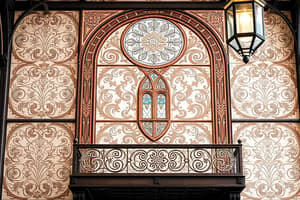Podcast
Questions and Answers
What is the purpose of steel column splices?
What is the purpose of steel column splices?
- To connect beams to columns
- To resist vertical loads
- To hold the column sections in position (correct)
- To increase the floor levels
What is the typical thickness of splice plates used for column splices?
What is the typical thickness of splice plates used for column splices?
- 20mm to 25mm
- 15mm to 18mm
- 5mm to 8mm
- 10mm to 12mm (correct)
What is used if the upper column differs in width or depth from the lower section in a column splice?
What is used if the upper column differs in width or depth from the lower section in a column splice?
- Thicker splice plates
- Cover plates (correct)
- Welded joints
- Vertical plates
When does a seated connection apply?
When does a seated connection apply?
What are column splices primarily designed to do?
What are column splices primarily designed to do?
What is the primary purpose of steel column splices?
What is the primary purpose of steel column splices?
What is the typical location for steel column splices?
What is the typical location for steel column splices?
What is used to attain full bearing area against the lower column when the difference in width or depth is quite great in a column splice?
What is used to attain full bearing area against the lower column when the difference in width or depth is quite great in a column splice?
What is the typical thickness of splice plates used for column splices?
What is the typical thickness of splice plates used for column splices?
What is a seated connection in structural steel assemblies?
What is a seated connection in structural steel assemblies?
What is the primary purpose of steel column splices?
What is the primary purpose of steel column splices?
What is the typical thickness of splice plates used for column splices?
What is the typical thickness of splice plates used for column splices?
In a column splice, what is used if the upper column differs in width or depth from the lower section?
In a column splice, what is used if the upper column differs in width or depth from the lower section?
Where are steel column splices normally located in relation to the proposed floor levels?
Where are steel column splices normally located in relation to the proposed floor levels?
What does a seated connection apply to?
What does a seated connection apply to?
Flashcards are hidden until you start studying
Study Notes
Steel Column Splices
- The primary purpose of steel column splices is to transfer axial loads from one column to another, ensuring continuous load-carrying capacity.
- Steel column splices are primarily designed to resist axial forces and ensure structural integrity.
Splice Plates
- The typical thickness of splice plates used for column splices is 1-2 inches (2.54-5.08 cm).
- Splice plates are used to connect two columns of different widths or depths in a column splice.
Column Splice Configurations
- When the upper column differs in width or depth from the lower section, filler plates or shims are used to attain full bearing area against the lower column.
- A seated connection applies to beam-to-column connections where the beam seats on top of the column.
Location of Steel Column Splices
- Steel column splices are typically located near the floor level, usually between 12-18 inches (30-45 cm) above the proposed floor levels.
Studying That Suits You
Use AI to generate personalized quizzes and flashcards to suit your learning preferences.




